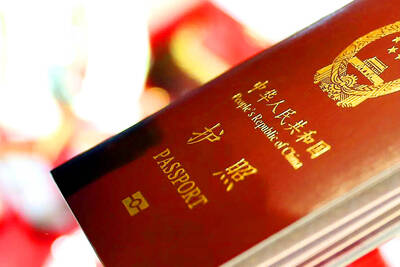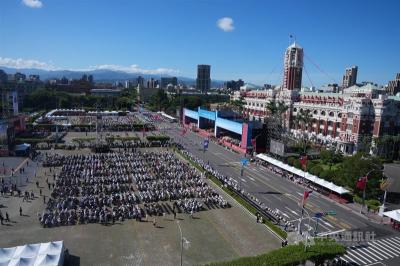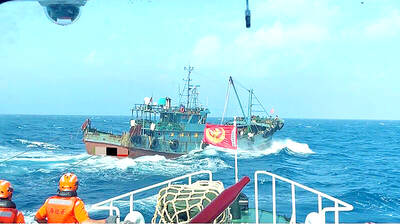While the US has been tied up fighting the war in Iraq, China has made huge gains toward modernizing its military and improving its equipment, and its air defenses are now nearly impenetrable to all but the newest of US fighters, the senior US military official in Japan said.
Lieutenant General Bruce Wright, commander of the roughly 50,000 US forces in Japan, Washington's biggest ally in Asia, said in an interview this week the Iraq War is reducing the availability of US troops and equipment to meet other contingencies and eating up funds that might be used to replace or upgrade planes that are being pushed to their operational limits.
China, meanwhile, is filling the skies with newer, Russian-made Sukhoi Su-27 "Flankers" and Su-30s, along with the domestically built J-10, a state-of-the-art fighter that Beijing just rolled out in January.
China has also improved its ballistic missile defenses and its ability to take the fight into space -- as it proved by shooting down an old weather satellite at an orbital height similar to that used by the US military.
Wright stressed he is "positive" about the current efforts to increase diplomatic and political engagement with Beijing. But he said the Chinese military buildup is disconcerting.
"Are we in trouble? It depends on the scenario," Wright said in the interview on Thursday. "But you have to be concerned about the small number of our forces and the age of our forces."
Wright said the US Air Force's fleet is older than ever.
The average age of the F-15 fighters, for example, is about 24 years, while that of the KC-135 Stratotanker, a mid-air refueling plane that is a key element in the Air Force's ability to conduct long-range missions, is 46 years.
Wright, who was at this air base on Japan's southern island of Okinawa to meet with local commanding officers, said the improvement in Chinese air defenses had made China's airspace "difficult if not impossible" to penetrate with the kind of US fighters -- F-15s and F-16s -- now deployed in Japan.
Doing so would require the F-22 or the Joint Strike Fighter, which both have stealth capabilities. The Air Force sent a dozen F-22s to Japan earlier this year, but only for a temporary deployment. It has no plans to send more there permanently.
The Joint Strike Fighter, or F-35, is not yet combat-ready.
"Our planes are much older than the planes they would be matched against," Wright said. "For the first time in history, we are seeing another nation, in this case China, with newer fighters than we have. We know that they continue to invest at a level that is unprecedented. We need to be watchful of Chinese military capabilities."
He said the demands of supporting ground troops in Iraq has pushed the Air Force to draw on its fighters from virtually anywhere they can be found. Two US F-16 fighter squadrons from the base in Misawa, Japan, are rotating in and out of Iraq.
"The question is how much more are they going to need," he said. "They are already pulling them out of Misawa, so where else are they going to come from?"
Wright said Beijing is also at an advantage because it is not at war.
Also see story:
Taiwan developing long-range missiles: analysts

The Ministry of the Interior (MOI) is to tighten rules for candidates running for public office, requiring them to declare that they do not hold a Chinese household registration or passport, and that they possess no other foreign citizenship. The requirement was set out in a draft amendment to the Enforcement Rules of the Public Officials Election and Recall Act (公職人員選舉罷免法 ) released by the ministry on Thursday. Under the proposal, candidates would need to make the declaration when submitting their registration forms, which would be published in the official election bulletin. The move follows the removal of several elected officials who were

The Republic of China (ROC) is celebrating its 114th Double Ten National Day today, featuring military parades and a variety of performances and speeches in front of the Presidential Office in Taipei. The Taiwan Taiko Association opened the celebrations with a 100-drummer performance, including young percussionists. As per tradition, an air force Mirage 2000 fighter jet flew over the Presidential Office as a part of the performance. The Honor Guards of the ROC and its marching band also heralded in a military parade. Students from Taichung's Shin Min High School then followed with a colorful performance using floral imagery to represent Taiwan's alternate name

COGNITIVE WARFARE: Chinese fishing boats transmitting fake identification signals are meant to test Taiwan’s responses to different kinds of perceived incursions, a report said Chinese vessels are transmitting fake signals in Taiwan’s waters as a form of cognitive warfare, testing Taipei’s responses to various types of incursions, a report by the Institute for the Study of War said on Friday. Several Chinese fishing vessels transmitted fake automatic identification system (AIS) signals in Taiwan’s waters last month, with one mimicking a Russian warship and another impersonating a Chinese law enforcement vessel, the report said. Citing data from Starboard Maritime Intelligence, the report said that throughout August and last month, the Chinese fishing boat Minshiyu 06718 (閩獅漁06718) sailed through the Taiwan Strait while intermittently transmitting its own AIS

CHINESE INFILTRATION: Medical logistics is a lifeline during wartime and the reported CCP links of a major logistics company present a national security threat, an expert said The government would bolster its security check system to prevent China from infiltrating the nation’s medical cold chain, a national security official said yesterday. The official, who wished to stay anonymous, made the remarks after the Chinese-language magazine Mirror Media (鏡周刊) reported that Pharma Logistics (嘉里醫藥物流) is in charge of the medical logistics of about half of the nation’s major hospitals, including National Taiwan University Hospital and Taipei Veterans General Hospital. The company’s parent, Kerry TJ Logistics Co (嘉里大榮物流), is associated with the National Committee of the Chinese People’s Political Consultative Conference (CPPCC) and the Chinese People’s Liberation Army (PLA), the